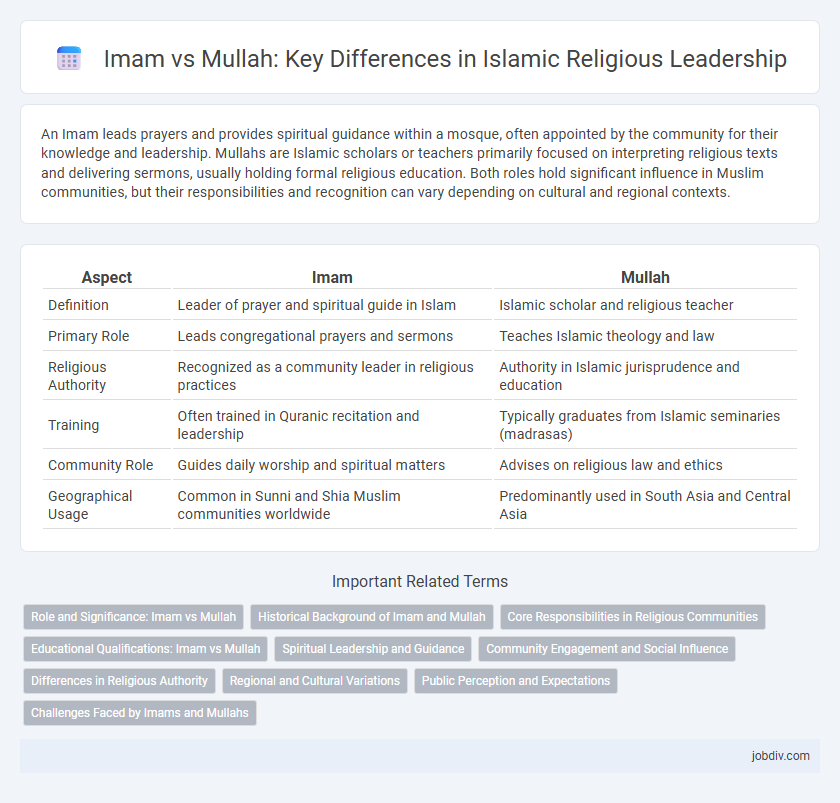An Imam leads prayers and provides spiritual guidance within a mosque, often appointed by the community for their knowledge and leadership. Mullahs are Islamic scholars or teachers primarily focused on interpreting religious texts and delivering sermons, usually holding formal religious education. Both roles hold significant influence in Muslim communities, but their responsibilities and recognition can vary depending on cultural and regional contexts.
Table of Comparison
| Aspect | Imam | Mullah |
|---|---|---|
| Definition | Leader of prayer and spiritual guide in Islam | Islamic scholar and religious teacher |
| Primary Role | Leads congregational prayers and sermons | Teaches Islamic theology and law |
| Religious Authority | Recognized as a community leader in religious practices | Authority in Islamic jurisprudence and education |
| Training | Often trained in Quranic recitation and leadership | Typically graduates from Islamic seminaries (madrasas) |
| Community Role | Guides daily worship and spiritual matters | Advises on religious law and ethics |
| Geographical Usage | Common in Sunni and Shia Muslim communities worldwide | Predominantly used in South Asia and Central Asia |
Role and Significance: Imam vs Mullah
Imams serve as spiritual leaders who lead prayers, deliver sermons, and provide guidance on religious and social matters within the Muslim community. Mullahs often function as Islamic scholars or teachers, focusing on religious education, interpretation of Islamic law, and community counseling. The significance of Imams lies in their role during worship and communal rituals, while Mullahs hold importance in religious jurisprudence and scriptural exegesis.
Historical Background of Imam and Mullah
Imams have historically served as spiritual leaders and guides in Islamic communities, often regarded as authoritative figures in religious interpretation and prayer leadership, particularly in Shia Islam where they are considered divinely appointed. Mullahs, originating from Persian and Central Asian traditions, function primarily as learned scholars and teachers of Islamic law and theology, playing a significant role in the dissemination of religious knowledge and jurisprudence. The distinction between imams and mullahs emerged through centuries of theological development, with imams embodying spiritual authority and mullahs emphasizing scholarly expertise in Islamic law and education.
Core Responsibilities in Religious Communities
Imams primarily lead congregational prayers, deliver sermons, and provide spiritual guidance within Islamic communities, emphasizing religious rituals and interpretation of Islamic law. Mullahs often focus on religious education, teaching Islamic theology, jurisprudence, and guiding community members on moral and social issues based on Islamic principles. Both roles are essential for fostering religious knowledge and maintaining communal worship practices in Muslim societies.
Educational Qualifications: Imam vs Mullah
Imams typically possess formal religious education, often graduating from recognized Islamic seminaries with extensive knowledge of Quranic sciences, Hadith, and Fiqh. Mullahs may have varying levels of education, ranging from basic religious instruction in local madrasas to advanced studies, but their qualifications are frequently less standardized than those of Imams. The distinction in educational rigor often influences their roles, with Imams generally entrusted with leading prayers and sermons in larger congregations.
Spiritual Leadership and Guidance
Imams serve as spiritual leaders in Islam, responsible for leading prayers, delivering sermons, and providing religious guidance rooted in scripture and community needs. Mullahs typically function as religious scholars or teachers, offering interpretations of Islamic law and theology, often focusing on education and jurisprudence. Both roles contribute to spiritual leadership, but Imams emphasize congregational leadership while Mullahs prioritize scholarly authority and religious instruction.
Community Engagement and Social Influence
Imams hold a prominent role in leading community prayers and providing spiritual guidance, often influencing social cohesion and local decision-making within Muslim communities. Mullahs typically focus on religious education and interpreting Islamic law, shaping community values through teaching rather than leadership in public rituals. The social influence of imams is more visible in communal activities, whereas mullahs impact social norms primarily through educational and judicial roles.
Differences in Religious Authority
Imams hold a central position in Islamic worship, often leading prayers and serving as spiritual guides within the community, whereas Mullahs typically function as scholars or teachers with expertise in Islamic law and theology. Imams derive their authority from their role in religious rituals and community leadership, while Mullahs gain respect through formal education and interpretation of religious texts. The distinction in religious authority lies in the Imam's focus on worship and communal guidance versus the Mullah's emphasis on scholarly knowledge and jurisprudence.
Regional and Cultural Variations
Imam and Mullah roles vary significantly across regions, with Imams often serving as community prayer leaders and spiritual guides in Sunni and Shia Islam, particularly in Middle Eastern and South Asian contexts. Mullahs, more common in Central Asia, Iran, and Afghanistan, frequently function as religious scholars or teachers with deep knowledge of Islamic jurisprudence and theology. Cultural variations influence their authority, responsibilities, and community status, reflecting local traditions and interpretations of Islamic practices.
Public Perception and Expectations
Imams often hold a leadership role in community prayers and spiritual guidance, fostering a perception of greater religious authority and moral responsibility compared to mullahs, who are typically seen as scholars specializing in Islamic jurisprudence. Public expectations of imams center on their ability to inspire, lead congregations, and offer practical religious advice during daily life and ceremonies. In contrast, mullahs are primarily expected to provide scholarly interpretations of Islamic law, serve as educators, and address doctrinal questions within the community.
Challenges Faced by Imams and Mullahs
Imams and Mullahs face challenges such as addressing diverse congregational needs while maintaining religious authenticity and adapting traditional teachings to contemporary issues. Both roles often encounter scrutiny over interpretations of Islamic law amidst evolving social dynamics and political pressures. Balancing spiritual leadership with community expectations requires continuous education, emotional resilience, and effective communication skills.
Imam vs Mullah Infographic

 jobdiv.com
jobdiv.com